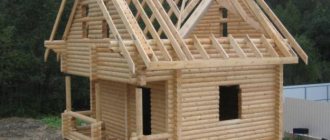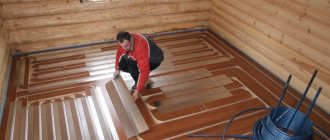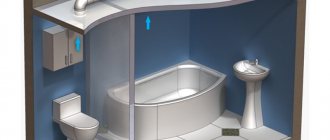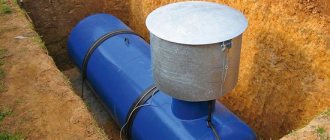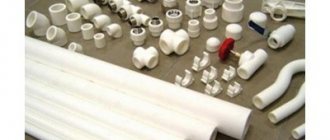Technique
0
1 155
Share
During a kitchen renovation, attention is paid to the beauty of the design and interior, so that the room is comfortable and cozy to spend time at lunch or dinner, but we forget about functionality and ventilation - this is a point that should not be overlooked.
Proper kitchen ventilation will allow you to enjoy fresh air
- Ventilation structure and diagram
- Some nuances of ventilation systems
- How to solve a problem
- Natural ventilation of the kitchen in a private house
- Hoods for the kitchen, toilet, extension, bath: installation
The main element of the room is ventilation with an exhaust hood, by installing which you always feel the presence of fresh air where food is constantly being prepared. After all, they fry, bake, cook here, the air is not clean and sometimes it is difficult to breathe, so in such a room a ventilation hood will be an excellent assistant that will renew air flows, remove excess vapors from mixed fats and seasonings and create a supply of pure oxygen.
Important! If ventilation in a private home is absent or poorly functioning, unpleasant odors have nowhere to go, and they spread throughout the entire residential building and are absorbed into clothes, things, furniture and other household items. It is worth preparing for the fact that your home will turn into a building with a constant unpleasant odor; the solution is a ventilation system.
Why is ventilation in a private home so important?
Ventilation is the exchange of air in rooms. Exhaust air is exhausted outside, and fresh air enters the rooms. What if this doesn't happen? Various pollutants will accumulate in the room - mainly exhaled carbon dioxide, as well as the ubiquitous dust, dust mites, and mold spores. There are also harmful chemicals emitted by furniture and various equipment, and if there are smokers in the house, there are also toxic compounds carried by cigarette smoke.
The air exhaled by people and the steam coming from the kitchen and bathroom cause an increase in humidity. Water vapor is deposited on cold surfaces, such as windows and corners of the room. Damp surfaces provide a breeding ground for dust mites, which live in house dust and mold. These microorganisms can cause allergies. Mold spores attack food and can also destroy the wall on which its colony forms.
Spending a long time in rooms that are poorly ventilated is very harmful. This stimulates drowsiness, headache, dizziness, poor attention, weakness. We may feel nauseated and generally tired and even depressed. Sometimes the body can react to stuffiness with irritation of the eyes and respiratory tract, and even cardiac arrhythmia. In addition, the carcinogenic impact of mold should not be underestimated. Therefore, it is very important to get rid of ventilation problems, if any.
It is known that the ventilation system must operate in the house and continuously remove any air pollution. In addition, it is necessary to ensure the safe use of gas appliances - boiler, heater, stove, fireplace. In case of any malfunction of these devices, toxic gases should be removed from the house immediately.
It is also necessary to remove excess moisture from the house, released by our breath, accumulated as a result of cooking, drying clothes, as well as odors that appear in indoor living spaces.
How much fresh air does your home need?
To provide housing with a sufficient amount of fresh air, it is first necessary to determine the need for air exchange. How to do it?
General recommendations and examples of calculating fresh air requirements
General recommendations in this regard are as follows:
- within an hour, as much air in the room must be replaced as the cubic capacity of the room;
- For each person living in a room, 30 m³ of air is needed per hour.
It is advisable to choose the larger of these two values.
Example.
A living area of 20 m² requires an exchange of 50 m³ of air per hour, but if it is a bedroom for two people, then 60 m³/h.
There is also an approach to calculation, which assumes that sufficient air exchange is 0.5-0.8 of the volume of the room per hour.
Example.
A living area of 20 m² requires an exchange of 25-40 m³/h.
However, it should be taken into account that in conditions of more intense pollution, more intensive air exchange will be required.
Types of ventilation - diagram
Depending on financial capabilities and preferences, we can use two types of ventilation:
- cheap home gravity ventilation;
- effective mechanical ventilation;
- the most energy efficient ventilation with heat recovery.
These recommendations should not be taken too literally. They may not be sufficient in a home where cigarette smoking, many people live, or where guests are frequently received. The amount of pollutants released is also affected by:
- how often and how many people wash and dry clothes;
- how many times a day do they take a bath or shower;
- how often it is cooked;
- type of oven (gas or electric);
- and even the location of the house - if it is in the shade, it will collect more moisture, which also provokes pollution.
The amount of fresh air that rooms such as the kitchen, bathroom, and toilet should receive is slightly different. They require intensive ventilation during use. So:
- the bathroom requires at least 50 m³/hour of fresh air;
- toilet – 30 m³/hour;
- pantry – 15 m³/hour;
- kitchen with electric stove – 50 m³/hour;
- kitchen with gas stove – 70 m³/hour.
Separate requirements apply to the living room with a fireplace, boiler room, laundry room and drying room.
How to determine whether the ventilation in the house is sufficient using the home method?
A home way to check whether ventilation is sufficient is to measure the indoor humidity during the winter. If it is no more than 50-60%, this means that the ventilation is working properly.
Requirements for ventilation systems.
The ventilation of a private house is arranged correctly if the following requirements are met:
- air from the ventilation duct is discharged onto the roof . With any ventilation system, the ducts are installed above the roof;
- with a mechanical ventilation system, air is taken in using a so-called intake grille located two to three meters from the ground;
- the movement of air flows is organized so that the air from the bedroom, living room, nursery and other living spaces moves to those rooms where the greatest pollution occurs. These include a bathroom, a toilet, and a kitchen. Thanks to this design of ventilation ducts, polluted air from the sewer or from the kitchen will not enter the living quarters;
- Gas ventilation is required for the kitchen. This is especially true if it has a gas water heater, and not just a stove. In this room, more than anywhere else, mechanical ventilation is needed;
- The design diagram of the ventilation system must cover absolutely all rooms in the house.
Air flow through valves.
In recent years, sealed metal-plastic windows are increasingly being installed in homes, completely limiting the natural flow of fresh air into the room. When choosing a metal-plastic window, you should check whether it has an inlet valve. It will allow the flow of outside air into the room. If the already installed windows do not have one, anyone can make a supply valve in the wall. This simple design is a round pipe mounted through the entire wall. Through it, outside air enters the room. The pipe is covered with gratings on both sides. If you install a wall supply valve in the room near the floor behind the heating radiator, fresh air coming from outside will immediately warm up well. These valves are often equipped with filters or temperature sensors. They are recommended to be placed in the dining room, living room, bedroom. Thanks to them, air moves from living rooms towards domestic premises.
How to properly make ventilation in a private house?
The amount of fresh air that must be delivered to the room, as can be seen from the calculations given above, is very large. And in winter it will have to be warmed up, since the fresh air is quite cold. This will entail very high costs, which will be higher the colder it is outside.
Therefore, ventilation systems should be assessed not only in terms of investment costs, but also taking into account operating costs. How to properly make supply ventilation?
Natural gravity ventilation
The simplest is a natural ventilation system. Air enters the room through ventilation openings and is removed through exhaust ducts. This system is inexpensive to produce. However, its disadvantage is the high cost associated with heating the incoming cold air - in a natural ventilation system we cannot completely control the amount of air that enters the room. The colder it is, the more cold air masses come in, and the more we spend on heating.
Mechanical ventilation
Another option is mechanical ventilation, in which a fan increases the air exchange in the home. Depending on the location of the fans and the entire system, ventilation can be exhaust or supply and exhaust. It can control the amount of fresh air that enters the interior of the house, but unfortunately we will have to pay additional heating costs again.
However, it is possible to reduce air heating costs. Cold air entering a room can be preheated using heat from exhaust air from the home or heat stored in the ground. For this, recovery devices are used (which we will discuss in this article below). They allow the supply air to be preheated, thus reducing overall heating costs.
How does natural ventilation work in a house?
Natural gravity ventilation - operating diagram
Choosing a ventilation system for a residential building.
The installation of ventilation in a private house begins from the moment of choosing its type. Maximum comfortable living for people in the house implies an influx of fresh air. In addition, the optimal speed of its movement is also important. Some owners, wanting to ventilate their homes well, install powerful mechanical ventilation. It uses a fan to supply/exhaust air. Some people do not take into account the area of their home and the power of the “hood”. But very often the air exchange in this system takes heat from the house and cools it greatly. If there is no urgent need for forced ventilation, it is better to limit yourself to natural ventilation. It creates optimal living conditions for people.
Each ventilation system has a certain rate of volumetric air velocity. With natural ventilation it is up to 1 m3/hour , and with mechanical ventilation it is 3 - 5 m3/hour . Unfortunately, in some cases it is impossible to do without the use of forced ventilation. This happens when the air flow rate in the house is very low, and there is no way to increase the cross-section of the ventilation duct. For example, with natural ventilation, to pass air in an amount of 300 m3/hour, air ducts measuring 250x400 mm (d 350 mm) . When using a mechanical system, you can limit yourself to a channel with a size of 160x200 mm (d 200 mm) . That is why, in cases where it is not possible to install a large natural ventilation channel in the wall, it is better to install mechanical ventilation. Forced ventilation is especially important for large buildings.
Ventilation of a house, video:
How to properly make natural ventilation in the house?
What does the installation of natural ventilation in a house consist of and how to make a ventilation system correctly?
The ventilation system consists of diffusers through which fresh air enters the house and ventilation ducts through which air is removed from it.
Diffusers can be factory installed in windows, but you can purchase completely sealed windows and install the diffusers in the wall. If you place them at a height of about 2 meters, then people will not feel cold air currents, since the outside air has time to mix with the warm air in the room. You can also install ventilation holes above the radiators - this way the cold air will immediately heat up.
Diffusers can be controlled manually or automatically. Using cheaper manual models, adjust the degree of opening of each of them. More convenient are automatic models that regulate the amount of incoming air to a specific level - pressure or humidity, less often: temperature, which is measured indoors and outdoors.
Ventilation ducts . The used air is blown out through the vents in the ventilation ducts. If they are equipped with a damper, you can regulate the amount of exhaust air and reduce it when the weather is too cold.
- Sometimes diffusers are installed in windows.
- They can also be installed in an external wall.
Photo. Diffusers for installation in the external wall of a building
Ventilation system - natural or mechanical
We discussed how to calculate air exchange and select the cross-section of the air duct in the article Classification and calculation of home ventilation systems.
For a person’s comfortable stay in the house, it is important not only the presence of fresh air and its temperature, but also the speed of air flow. And the smaller it is, the more comfortable it is to be in the room. The air exchange in a room with mechanical supply and exhaust ventilation (supply and exhaust fans) is greater than in a room with natural ventilation. This is due to the different normalized volumetric speed of air movement in the ventilation system for them. For mechanical ventilation it is 3-5 m3/hour, and for natural ventilation no more than 1 m3/hour, that is, 3-5 times less. Therefore, natural ventilation of the house creates more comfortable conditions for people.
But there is one “but”, because of which it is sometimes impossible to do without mechanical ventilation. The fact is that the lower the speed of air movement through the channel, the larger its cross-section is needed. Those. in order to pass the same amount of air, the cross-section of the ventilation duct for natural ventilation will be larger than for mechanical ventilation. For example, if we talk about exhaust hood, then in order to pass 300 m3/hour of air you will need a 250x400 mm channel (or 350 mm in diameter) with natural air movement, or a 160x200 mm channel (or 200 mm in diameter) with mechanical exhaust. It is not always possible to place a large natural exhaust duct in the wall, and moving it outside the wall - under the ceiling or along the wall (as in office premises) is not always aesthetically pleasing in residential buildings. Therefore, with large areas of the house and correspondingly large figures for the required hood, it is often necessary to resort to mechanical hood. The flow of air into the room is also not always possible to do only in a natural way; more about this will be later.
Air flow
Scheme of organizing flow in a ventilated space
1 - air flow zone; 2 - air flow zone; 3 - air exhaust zone.
Whatever the type of supply and exhaust (natural or mechanical), in order for the air to move freely throughout the house from the supply units to the exhaust units, it is necessary to install flow grilles in the doors along the path of its movement. The flow of air is considered to be organized correctly if the most polluted room in the chain of air movement is the last. That is why the hood is usually installed in the kitchen and bathroom.
Door with overflow grille
Or leave a gap between the bottom of the door and the floor, at least 20 mm across the entire width of the door.
Gap under the door for free air movement
If there is no such gap in the doors, then the entire ventilation system in the house can be considered not working. In addition, you will hardly be able to open doors leading to a bathroom without a ventilation grille with a running exhaust fan (due to excess pressure).
Air flow
What causes the air flow, how to understand whether there is enough air in your home and what measures to take to increase the amount of supply air we will consider further.
As already mentioned, air flow can be carried out naturally or forcefully.
Infiltration is a natural influx through leaks in external barriers (windows, external doors and walls of the house).
Natural air flow through leaks in window and door openings
As you know, ordinary old-style wooden windows have fairly high air permeability (about 10-20 kg/hour*m2). With a small house area, about 100-140 m2, the volume of fresh air penetrating through the cracks and the leakage of such windows is usually sufficient to ensure the necessary inflow. In addition, it is also added to, not so significant, but nevertheless, the flow of air through the leaks of the external doors, as well as the flow through the walls.
Natural influx through ventilation
Ventilation through an open window or crack when the folding frame of a metal-plastic window is slightly opened
Metal-plastic windows in ventilation position
- carries with it large heat losses;
— as a result of such ventilation in winter, the window unit and adjacent slopes cool down, until condensation forms on them;
— air exchange (complete replacement of old air with new) is carried out in 30-75 minutes.
Ventilation with fully open windows
Ventilation with fully open windows
- rapid exchange of air in the room - only 4-10 minutes;
— there is no cooling effect on structures.
Ventilation with windows and front door fully open
Ventilation by opening all windows and the front door
- draft dangerous to health;
- the fastest possible air exchange - 2-4 minutes when all windows of the house and the front door are opened.
Note: If it is necessary to ensure a single air exchange in a room (Table 4 DBN V.2.2-15-2005 Residential buildings), this means that within an hour in this room a complete exchange of air for new air must be carried out. And if ventilation is the only source of fresh air in your home (for example, the walls of the house are insulated with airtight foam or EPS insulation and there are airtight metal-plastic windows), then to ensure a microclimate that is comfortable and safe for your health, you must ventilate this room every hour using one of the methods described above . If you see this option as inconvenient or simply impossible for you, then consider installing supply valves, which will be discussed further.
Natural inflow through supply wall and window valves
In the last decade, the installation of windows made of metal-plastic has become very popular, one of the features of which is tightness. And the technology for installing such windows does not provide for leaks to remain. Thus we are deprived of natural influx. The air permeability of metal-plastic windows is no more than 0.1 kg/hour*m2, i.e. practically zero. What to do in such a situation? The solution is simple. Firstly, when choosing and ordering windows, we recommend considering the option of window units with an already built-in adjustable ventilation slot in the upper part of the window frame - a supply window valve.
Window with supply valve
If the windows have already been selected, purchased and installed, you can install an air infiltration valve - a supply wall valve.
Wall supply valve
The supply wall valve is a round pipe, which is mounted into the wall (through and through), and is closed with grilles on both sides. The internal valve grid is adjustable from fully closed to fully open. It is advisable to install this valve near window openings, then they can be masked with tulle, and the incoming air will also enter the radiators that are located under the windows.
Air flow in the radiator coverage area
For the same purpose, you can install a valve directly behind the battery, then the incoming air will immediately warm up.
Installing a supply valve directly behind the radiator
Valves can be equipped with filters, as well as humidity and temperature sensors. It is recommended to install dampers in the bedroom, hall and dining room in order to maintain the direction of air movement from clean areas (living rooms) to household areas (kitchen, toilet, bathroom).
The same valves often have to be installed in houses insulated with vapor-proof insulation, such as polystyrene foam or EPS. The walls become vapor-tight, and accordingly the amount of supply air in the house decreases.
Most supply valves supply 50 or 100 m3/h of fresh air. In order to select the required number of valves, you need to calculate the required amount of supply air (L in) using the calculation given in the article Ventilation of the house. Classification and calculation of home ventilation systems.
House with installed wall inlet valve
Forced inflow using suction fans
There are cases when the required air flow is so great that you need to install supply valves under almost every window in the house, but you don’t want to do this, for example, for aesthetic reasons. Then a forced air system is right for you.
The supply system consists of ventilation equipment and a ventilation network. The equipment includes: air valve, filter, heater, fan and silencer. And the network includes the air intake grille, air ducts and air distribution devices (grills, diffusers, anemostats). A set of supply ventilation equipment is shown in the figure below. A filter in the supply ventilation system is necessary to remove large dust particles that are present in the street air. Heater - for heating air during the cold season, they are not available in all systems, they are installed at the request of the customer and can be water or electric. When using water heaters, the ventilation system must be additionally equipped with mixing units (hydraulic piping of the heater), which in turn increases the cost of the system.
Scheme of a set of equipment for supply ventilation
If the house has mechanical not only air supply, but also air exhaust, then it makes sense to install an air recovery system in order to save energy on heating the supply air. The recovery system will be discussed in more detail a little later.
Air extraction
If the cottage is being built from scratch, then it is necessary to provide for ventilation ducts in the internal walls of the bathrooms, toilets, and kitchens. Channels should be made of brickwork in internal walls (as a rule, they are designed in the architectural section of the project).
Brick ventilation duct
Therefore, exhaust ventilation in a private house is planned before the construction of walls begins. If it is not possible to place ventilation ducts in the wall, then they can be made in the form of attached shafts.
Types of ventilation ducts
a - placement of ventilation ducts in a brick wall;
b - ventilation ducts;
c - suspended ventilation duct;
d - output to the roof of the ventilation shaft.
Natural exhaust
If the amount of air that needs to be removed (Lout) is small, and the cross-section of the exhaust duct selected from the diagram fits in the wall (or does not fit, but you are ready to make an additional duct), then you can get by with a natural hood. The channel from inside the room, in this case, is simply closed with a ventilation grill.
Various types of ventilation grilles
Mechanical hood
If the cross-section of the channel during natural exhaust is too large, then it can be reduced by making the exhaust mechanical by installing exhaust fans in bathrooms and toilets.
Exhaust fans
There are many types and types of exhaust fans for bathrooms and bathrooms on the ventilation equipment market. The most popular are wall fans, which are mounted on the wall and go directly into the ventilation duct. And hidden-mounted fans, they are mounted in the ceiling space and are also discharged into the duct through an air duct. We select the fan according to the pre-calculated exhaust flow rate (Lout), taking into account the pressure loss when air moves through the air ducts. Those. the fan is not selected strictly for the Lout number, but with a margin for pressure losses, which sellers of ventilation equipment can usually calculate if you tell them the length and material of your air ducts.
The control of a mechanical hood for bathrooms is often connected to a light switch. Such hoods can be delayed in time, for example, by 50 seconds, after they are turned on (a person has time to wash their hands) or with a delay of 50 seconds after turning off the light. Bathroom fans can be equipped with humidity sensors, i.e. work until normal humidity is established in the room. These hoods are a little more expensive than regular ones.
A completely silent fan, of course, can only be in the off state, but there are fan models that are quieter than others, for example those equipped with noise-reducing rubber-metal bushings. They dampen noise and vibration from engine operation.
Scheme of supply and exhaust ventilation in the building
1- exhaust fan; 2 - air flow through the leaks of the window opening; 3 — air flow through the supply valve; 4 - flow grille in the doorway.
Air movement on the floor
How to cheaply increase the efficiency of ventilation in your home?
The easiest and cheapest way is to install exhaust fans in the ventilation ducts. They can be controlled manually or automatically (for example, they can respond to the turning on of a light or movement in the room). The air flow in this case is carried out in the same way as in gravity ventilation systems - through diffusers. Fans are usually placed in the kitchen, bathroom and toilet, or where there are odors and moisture that need to be removed as quickly as possible.
Using a fan provides effective ventilation of the house on warm summer days, but it also has disadvantages:
- additional costs associated with the electricity consumption of these devices;
- Another disadvantage is the noise they make, which can be avoided by installing fans at the end of the exhaust duct on the roof.
Is it possible to control the air supply and exhaust?
Regulation of not only the amount of exhaust air, but also the supply can be ensured in the supply and exhaust ventilation system. How to properly install exhaust and supply ventilation? This requires two fans - supply and exhaust, which can be placed away from the rooms, for example, in the attic - this is a good option.
The fans are connected to all rooms via two pipelines: supply and exhaust. One provides fresh air, the second removes polluted air. Although this requires more money, in this way you can completely control the amount of air entering individual rooms, and we can also install additional equipment in such a system:
- filters that purify incoming air;
- air heater for preheating;
- an air humidifier, which will improve its quality in winter, when the rooms are usually too dry.
How to save energy used for ventilation in the house?
Installing a supply and exhaust installation usually entails another solution - installing a heat recovery (that is, recovery) system. Although the air handling unit is expensive, and with a heat recovery air handling unit it will be even more expensive, this design will help reduce operating costs, which will pay off in the future through heat savings.
When ventilating a house in winter, we lose a lot of heat, which is removed outside along with polluted air. The incoming fresh air needs to be heated - and this can increase by up to half the cost we pay for heating the house during the same time. If, for example, the cost of heating is 3,000 rubles, then taking into account ventilation losses, it can rise to 4,500 rubles!
That's why there is increasing interest in devices that can retain some of the heat that would normally be lost through heat recovery, as well as through a ventilation system in which fresh air is preheated in the ground.
The principle of heat recovery in a cross-type heat exchanger
A little about natural ventilation
Ventilating a private home is a difficult task. Unlike apartment buildings, one inlet and outlet openings and a pipe cannot be used here. Only meticulous calculations make it possible to create a truly functioning complex natural system of many elements. Remember that the slightest mistake leads to discord in your work. There is a system, but there is no point.
Remember that the slightest mistake leads to disruption in work
Remember! Natural ventilation makes it possible to save money and works without outside interference or any additional devices.
What should you pay attention to during installation? What are the most common errors:
- ventilation holes are located where it is convenient, beautiful, does not interfere, etc. the correct place for them is no lower than 10 cm from the ceiling, but in fact they are lowered much closer to the floor. As a result, polluted air does not go anywhere, it simply hangs over the heads of residents;
- the ventilation pipe must be of a strictly defined length, but many people ignore this point, which causes air stagnation;
- in order to save money, some people make one ventilation for several rooms at once;
- Often in kitchens only forced ventilation is installed, ignoring natural ventilation. Remember, this is prohibited by the rules! And very bad for the air in your home.
Related article:
Vestibule interior design: simple and stylish
At the same time, in most cases you can’t get by in the kitchen with natural ventilation alone. Additional devices will come to the rescue to promote the flow of fresh air and purification.
How does heat recovery ventilation work?
How to properly ventilate a room so that it is energy efficient? A modern and relatively simple method is recovery. The main element of such a system is a heat exchanger - recuperator. A stream of cold air passes through it and a stream of exhaust warm air is released. The special design of the heat exchanger allows the exhaust air to transfer some of the heat to the incoming air. How efficiently a device transfers heat depends on the indoor and outdoor temperatures, humidity and the design of the heat exchanger.
This device is useful not only in winter. On hot summer days you can cool the supply air in this way.
It is not beneficial to use a recuperator only during transition periods, when the temperature difference between inside and outside is small and heat recovery becomes uneconomical. In order for air to pass through the recuperator, two fans are needed - for air supply and air exhaust, and their operation also costs money, since they also consume electricity.
The heat exchanger with fans is part of a device called a heat recovery ventilation unit. In addition to the heat exchanger, the thermally and acoustically insulated housing panel contains air filters and sometimes a heater.
This is what a unit with a cross-type recuperator looks like
The external elements of a heat recovery system are an air intake through which air enters the interior, and an outlet chute located at a distance from the air intake through which the exhaust air is discharged outside.
Fresh air enters the housing through air intakes, where it is cooled in the summer and warmed up in the winter, and enters the room through ventilation ducts. The exhaust air is discharged from the ducts back into the body of the device, where it gives off heat and is then removed from the building.
The recuperator can be installed in the attic or basement. This requires four connecting pipes - two inlet and two outlet. The exhaust air inlet is connected to the pipe system in the kitchen, bathroom and toilet, and the fresh, heated air outlet is connected to ventilation ducts with adjustable end diffusers located in the living room, hallway and bedroom. The remaining two tubes go outside the building.
System composition, step-by-step installation
It will help when designing ventilation in a private house with your own hands, a diagram and preparation of a set of drawings with floor plans. The main element of any ventilation system is the air duct:
- ventilation duct - made only inside brick walls;
- box - made of steel sheet, polymer materials, ceramics, concrete products.
Exhaust air ducts have the maximum cross-section. For example, for a single air exchange in a cottage of 300 square meters with natural air exchange, you will need a pipe with a diameter of 35 cm or a channel 40 x 25 cm. Such structures can be made without problems inside brickwork.
Composition of forced ventilation
If the house is built from other structural materials, problems automatically arise with the placement and decoration of pipes or boxes of such large sizes. Therefore, the cross-section of the air duct is reduced, forced ventilation is designed in a private house (the diagram can also be done with your own hands without problems when studying the basic requirements of regulatory documentation).
How to organize ventilation?
To renew air masses in a private house, supply ventilation is first used. It’s not difficult to draw up a diagram with your own hands, once you understand the layout and features of your home. There are several types of ventilation that are not equally beneficial for the microclimate of interiors:
- the door + windows are open – the air is renewed within 5 minutes, but harmful drafts are formed;
Ventilation of windows and doors
- a transom or window is slightly open - complete replacement of exhaust air masses with new ones occurs in 40-60 minutes, but the slopes and window blocks cool down, and condensation may form;
Ventilation with vents
- windows are open - this option is the best, since in 10 minutes the structures do not have time to cool down, the air in the room is completely renewed.
Ventilation with open windows
But it is extremely inconvenient for residents to ventilate every hour. Therefore, a saving solution if you do not want to install a full-fledged air supply system are wall/window valves.
Ensuring inflow
Window valves come in several varieties. To install some models, it is necessary to mill an oval slot in the PVC profile in use. This is reflected in the strength of the window block (the profile is reinforced with foil, inside of which it is not recommended to make large holes), and sound insulation.
Window valve design
Slot valves of the overhead type are more convenient to install. To do this, it is enough to remove the seal in a separate area (usually the upper part of the transom) and screw on the valve body.
In high-performance modifications of supply-type valves, the external air intake is connected to the internal adjustment mechanism by a telescopic chamber. The valve element, installed indoors, has a filter, outlet nozzles, and a labyrinthine duct system.
Helpful information! All supply-type window valves are non-volatile. They will not work in buildings with leaky door and window units, or in the absence of 2 cm gaps under the interior door leaves.
The capacity of window valves is usually sufficient for residential premises. However, in kitchens with 4-burner gas stoves and ovens, these devices cannot provide the required air exchange for these rooms. Therefore, wall valves are installed with the following design:
- a tubular-type pipe (sleeve) installed inside a through hole in the wall;
- grilles on both sides for air filtration, decorating the opening, and adjusting the air intake;
- built-in fan or heat exchanger.
Design of a wall supply valve
Related article:
Supply valve to the wall. Such a device can sometimes be a real salvation from stuffiness and poor microclimate. Let's take a better look at the nuances of its selection and installation.
Conventional valves are mounted above heating registers so that winter air is warmed by rising convection currents. The recuperators use a “pipe in pipe” scheme, so the incoming masses are warmed by the outgoing flows. They are installed in any convenient place, regardless of the location of the batteries or walls.
Location of the supply wall valve
Ventilation systems using air ducts are more complex. Boxes or pipes are passed inside the spaces of suspended/stretch ceilings, releasing pipes in separate areas of the room.
Helpful advice! When organizing forced inflow by fans, the built-in ventilation ducts of a natural ventilation system are guaranteed to be unable to cope with the removal of large volumes of exhaust “dirty” air. Therefore, it will be necessary to install exhaust fans inside them.
What types of recuperators can be used in the ventilation system?
The most popular are plate-type recuperators. Their operation is very simple - streams of hot and cold air flow parallel to each other between the heat exchange plates, which ensures heat exchange without mixing. Two fans move the air. The efficiency of heat recovery in such a recuperator is 60-70%.
Control panel with cross flow heat exchanger
Counterflow heat exchangers are designed very similarly, only the air passes through them a little differently. Such devices are larger in size, but have higher efficiency - up to 90%.
Tubular heat exchangers are sometimes used, however, due to their large size, their use is limited, despite their relatively high efficiency - above 90%.
Rotary heat exchangers can also be found on sale. They are very efficient - efficiency is 80-90%. But they can allow a small amount of exhaust air to enter the fresh air, which can lead to the spread of odors in the house. Their advantage is partial removal of moisture. Proponents of rotary heat exchangers say odor transfer is negligible. Such models are very popular in the Nordic countries - Scandinavia.
Recuperator with rotor, photo
In a house where allergy sufferers live, you can use a filter to supply air, thereby removing allergenic particles.
When purchasing a recuperator, you should choose a model with a smooth five-stage variable fan speed. The more adjustment possibilities, the better the recuperator regulates the speed in accordance with the air exchange needs.
Ventilation systems with recovery
Recently, air handling units with energy recovery have become very popular. This is explained by the fact that when fresh supply air enters the house during the cold season, we spend a huge amount of thermal energy heating it. Recuperation systems allow you to save about 50% of heat due to partial heating of the supply (cold) air with the exhaust (warm) air. Partly because the heat of the exhaust air is not always enough to heat the cold supply air to +20 ºС. Therefore, in severe frosts, the supply air is heated by a heater built into the recuperator. In such a system, both the supply and exhaust are mechanical, since air is supplied and removed forcibly by supply and exhaust fans, as can be seen in the figure below.
Operating principle of the recovery system
If the house has air conditioning systems, then in the summer the supply air will be partially cooled. This in turn will reduce the load on the air conditioning systems. The operating principle is as follows: the exhaust air cooled by the air conditioning system, passing through the recuperator, cools the warmer supply air.
Location of recovery system equipment
In cottages with a large area, air exchange sometimes exceeds 800 m3/hour. Consequently, the dimensions of mechanical ventilation units will be large. It is best to decide in advance on their installation location; this could be a technical room in the basement or an attic space. If an attic is selected, it must be insulated to prevent freezing of the coolant and damage to the ventilation equipment (if equipment for internal installation is provided). Below, the figures show examples of the location of ventilation system equipment with recovery in the attic (a) and in the technical room (b).
Figure a. An example of supply and exhaust ventilation in a house with ventilation equipment placed in the attic
Figure b. An example of supply and exhaust ventilation in a house with the placement of ventilation equipment in a technical room
Types of air ducts
With the forced ventilation option, air ducts are used to distribute supply air throughout the house and remove exhaust air (for example, as in the air recovery system in the figure above). Which is better to use an air duct: round, rectangular or flexible?
Round duct
Round air ducts with a perfectly smooth surface have the least resistance to air movement, while rectangular ones have more resistance.
Rectangular duct
In flexible air ducts, the air resistance is the greatest, due to the uneven corrugated surface. But they are the only ones suitable in cases where the channel turns several times over a short section or when, for example, a kitchen hood needs to be connected to the main (main) channel.
Flexible duct
For example, the wiring of air ducts at home can be done as follows: the main air ducts can be made rigid (galvanized), and the branches can be made with flexible corrugated air ducts. Air ducts from the intake grille to the ventilation unit (or to the heater in a dial system) must be insulated to prevent condensation.
Kitchen hood
Kitchen hood
Often, when configuring a home ventilation system, the question arises: is it taken into account when calculating ventilation that part of the air is removed by the kitchen hood? No, it is not taken into account. This is due to the fact that the kitchen hood is turned on only occasionally and you simply cannot count on it during downtime. After all, a kitchen hood is designed to remove odors, steam and, first of all, harmful substances at the place of their formation - above the stove.
In this article, we examined possible options for ensuring proper inflow and exhaust in the cottage. I hope they will help fill the walls of your home with fresh and clean air.
How can you use the natural heat of the earth in a ventilation system?
If fresh air enters the house through a ground heat exchanger, this will allow the ventilation system to use natural heat or cold that accumulates in the ground: at a certain depth, the ground temperature is almost constant and does not depend on the outside air temperature. Such a heat exchanger can be used all year round - in winter it warms the outside air and cools it in summer. The efficiency of heat transfer depends on the surface area of the heat exchanger, the depth at which it is located and the intensity of the air flow.
Construction of a gravel heat exchanger - diagram
Tubular heat exchanger design - diagram
A ground heat exchanger is built as a pipe system or a layer of gravel is used. Air is drawn in through the inlet. The cold obtained from the earth can completely satisfy the needs of a private single-family home during hot weather.
A precondition for proper operation of the heat exchanger is that it is properly sized. It can't be too small because the ground will then stop giving off enough heat or taking it in during periods when the system is being used for cooling. Such a device does not require electricity and is therefore very economical.
The ground heat exchanger for recovery only works when it is hot or very cold. During the transition period, it is turned off and air is exchanged from an external air intake located on the wall of the building.
VENTILATION STANDARDS
In accordance with sanitary rules, ventilation systems must have a certain performance:
- for residential premises - from 3 m3/h per 1m2;
- for combined sanitary zones - 50 m3/h per 1 m2;
- for separate sanitary zones - 25 m3/h per 1 m2.
LOCATION OF VENTILATION DEVICES
Exhaust devices are installed in places where harmful emissions are generated in order to localize them and prevent further spread.
EVERYTHING YOU NEED FOR THIS ARTICLE IS HERE >>>
Supply ventilation is installed where residents spend a long time, for example, in the bedroom or living room. The temperature and purity of the supplied air must comply with sanitary standards.
